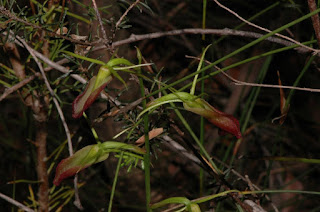It is very hard to say I have a "favourite Orchid", but Cryptostylis subulata goes very close to being that.
It was one of the first local Orchids I found and identified when I first moved to Robertson, so, it has precedence, if nothing more. Mind you, it is closely followed by the Flying Duck Orchid, which was the first Orchid I ever featured on this Blog. And there was a nice one there just yesterday. So that other species still rates pretty highly as far as I am concerned.
The first thing I ever learnt about this Orchid was its "wrong name" - Cow Orchid. Like all good "bad names" it tended to stick, because the idea of the long protruding "muzzle" and the two "horns" sticking back from the supposed cow head was a compelling mental image for me.
 | |
| Cryptostylis subulata - Large Tongue Orchid - looking a bit like a cow's head |
Having ruined this Orchid's name for you, I shall now try to recover my botanical purity, and give you some of the finer details of this strange Orchid, its growth habits and its pollination requirements and its deception techniques.
Firstly the leaf of this Orchid remains visible most of the year (unlike many Orchids). This gives one a sporting chance of finding it, and remembering where to go looking for it again, in flowering season. (From now till March in the Southern Highlands - earlier in the coastal areas).
The leaf is quite tall - as much as 30 cm in some cases. And importantly, it has a clear green back (of the leaf), not burgundy-red like its local cousin, Cryptostylis leptochila. The leaf of this species is elongated, whereas Cr. leptochila tends to be ovate in shape.
Ok - so that is what to look for during the off-season.
 |
| Green back to the leaf of Cryptostylis subulata |
When the plants are in flower, this is what you hope to find.
 |
| Cryptostylis subulata with four flowers (one out of frame) |
Here is the flower up close.
(refer back to the previous image,
to check the angle at which the flowers hang).
to check the angle at which the flowers hang).
For photographic purposes, it works best to tilt the stem
during the shoot (or tilt the camera).
Note the stem is on the lower left, and is leaning diagonally.
In fact the stem is normally vertical, (but not always).
 |
| Cryptostylis subulata - the Large Tongue Orchid seen from a low angle. |
And here is a hint to its "special features"
This flower has been knocked over by an animal, presumably.
I swear I did not push it over, in this case, just to "get the shot".
You can just see the dark strip of glands underneath the flower.
Those glands produce a special scent.
Those glands produce a special scent.
 |
| Underneath view of Cryptostylis subulata shows scent glands. |
Those glands are the key to its reputation
as a "deceptive" plant.
It produces scents which mimic the pheromones
of a female wasp.
That "trick" dupes the male wasp
into attempting to mate with the Orchid.
into attempting to mate with the Orchid.
This process used be referred to as "pseudo-copulation"
but that term seems to be going out of favour.
My Blogging colleague Margaret Morgan wrote
when one of these Orchids came up in her backyard, in Sydney.
Here are three links to images which show the wasp attempting
to mate with the flower
(just in case you do not believe the story.).
- http://ozibushpics.com/gallery/main.php/v/Flora/Orchids/album10/My_Pictures0019.jpg.html
- http://estherbeaton.photoshelter.com/image/I0000Yz8Bw69fbDo
- http://www.australiangeographic.com.au/journal/view-image.htm?index=2&gid=10376
Here is my best attempt at photographing the glands
underneath the flower.
underneath the flower.
(That is a reference to the fact that I am still
in "recovery" from a Hip Replacement Operation
and my mobility is extremely limited).Unlike the related Cryptostylis lepochila
this flower hangs down,
which means the sexual organs of this flower
(the white bit just visible)
which means the sexual organs of this flower
(the white bit just visible)
are at the "top"*** of the flower
That means the wasp has to approach
the flower upside down too.
the flower upside down too.
 |
| Black glands underneath the flower of Cryptostylis subulata. |
The white part of the flower
at the 'top right of the image"
is where the Orchid's sexual organs
(the Column and the pollinia) are located.
at the 'top right of the image"
is where the Orchid's sexual organs
(the Column and the pollinia) are located.
Margaret Morgan's colleagues at Macquarie University
have even captured the whole deal on a short video (1 min, 10 seconds).
The first example is with another Tongue Orchid species,
Cryptostylis erecta.
Cryptostylis erecta.
But in the middle (about 25 seconds into the clip),
there is one brief sequence involving this species too.
You will notice that the Wasp
has to hang upside down - on this species -
for reasons I have already explained.
has to hang upside down - on this species -
for reasons I have already explained.
But it is good to see the "process" in real time imagery.
*** In Botanical terminology, the part of the flower closest to the stem is the "base", regardless of the angle at which the flower is pointing. But for this purpose, I am referring to the part of the flower which is highest as the "top".
See you all next year!

























































